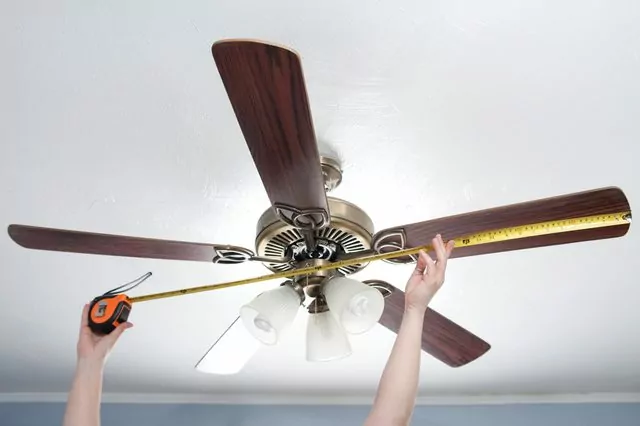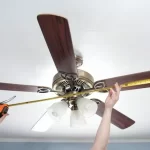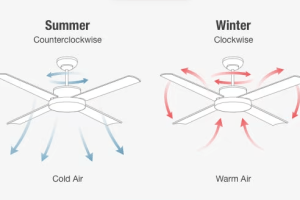We all have ceiling fans in our homes right? It does its job wonderfully of keeping us cool in moderate warm seasons. You must have heard from your friends, family, or neighbors that their fan is not doing well. The main reason for not a proper cooling from the fan is the fan size. Yes, the fan size must be well enough as per the area in the room or hall or anywhere.
For example, you can’t set a small ceiling fan in a big bedroom. It won’t work because it has cover a big space, it needs to have bigger blades.
In this article, I am going to discuss about the fan size and how you can measure it. Let’s dive deep into the topic, and find out…

Contents
Why Measure A Ceiling Fan?
Before moving forward let’s explore why it’s important. A ceiling fan isn’t just a functional appliance; it’s an item that can make a difference on both hot and warm days, and it also occupies the centerpiece of your room ambiance. Choosing the right-sized fan ensures that your space stays cool and looks cool too. Too small fan in a big room, and you’ll be left sweltering on hot days; too large, and it might feel like a windstorm in your room. So, measuring it correctly as per the area it has to cover, is crucial for both comfort and aesthetics.
How To Measure A Ceiling Fan?
Step 1: Size up your space
The first step in this measuring adventure is to assess the room size and height where your ceiling fan will be fitted. Think of it as laying the foundation for a skyscraper; it needs to be solid and precise.
- Choose a wall in your room preferably select a wall without big furniture or obstructions.
- Using a trusty tape measure, find out how long the wall is from one end to the other. Then, measure the width of a wall that’s opposite to the one you measured.
- Now, here comes the fun part. Multiply the length and the width of your room to calculate its square footage. For example, if your room is 10 feet long and 12 feet wide, the square footage is 120 square feet.
Pro Tip: If you’re dealing with inches, multiply the length and width, and then divide the result by 144 to get square feet.
Step 2: Measuring the fan blades
With your room size in mind, it’s time to focus on the star of the show – the ceiling fan itself. Think of it as measuring the wingspan of a majestic bird.
- Make sure the ceiling fan is turned off and the blades have come to a complete stop.
- Stand on a steady platform, like a stepladder, if needed, to have a clear view of the fan.
- Using your tape measure, measure from the tip of one fan blade to the tip of the opposite blade. If your fan has an even number of blades, measuring from one tip to the opposite tip is sufficient.
- For fans with an odd number of blades, measure to the center of the fan, and then multiply this measurement by 2 to find the total blade span.
Pro Tip: Accurate measurements here determine the fan’s blade span, which affects how much air it can circulate.
Step 3: Consulting the size ratio chart
Now that you have the room size and fan blade measurements, it’s time to determine the ideal fan size for your space. This step is like picking the right-sized paintbrush for a masterpiece.
Check out this helpful size ratio chart:
Ceiling Fan Size Chart
| Room Square Footage | Recommended Fan Sweep (Blade Span) |
| Up to 75 sq. ft. | 29-36 inches |
| 76-144 sq. ft. | 36-44 inches |
| 145-225 sq. ft. | 44-54 inches |
| 226-400 sq. ft. | 50-60 inches |
This chart acts as your compass, guiding you toward a fan with the right blade span based on your room’s square footage. Think of it as matching the brush size to the area you want to paint.
Step 4: Determine a fan’s height
We’re almost at the finish line! Now, let’s consider the ideal height for your ceiling fan installation. This step is like hanging a prized artwork at just the right level for everyone to admire.
Recommended Height
Ceiling fans should ideally be mounted between 7 to 9 feet above the floor. This height ensures both safety (no accidental head bumps) and effective air circulation.
Low Ceilings
If your ceiling is lower than 7 feet, consider installing a low-profile ceiling fan, also known as a hugger fan. These fans don’t need a downrod and are perfect for rooms with limited vertical clearance.
High Ceilings
For ceilings taller than 9 feet, use a downrod to bring the fan within the recommended height range. Don’t forget to choose a compatible downrod from the fan manufacturer that matches your desired finish.
Pro Tip: In rooms with sloped ceilings (more than 32 degrees), you might need a slope-mount fan to ensure a secure installation.
Some Tips to Take Into Account
Before we wrap up, here are a few additional factors to keep in mind when measuring a ceiling fan:
- Make sure the fan blade tips are at least 18 inches away from each wall for safety and proper airflow.
- If your fan includes lights, remember that they take up space. Factor in the light kit’s height when measuring for clearance.
- Choose a section of the ceiling that can support the fan’s weight and ensure it’s not obstructed by cabinets or other fixtures.
- Remove any obstacles that may block your fan blades from spinning properly. This includes light fixtures, décor, or existing structures.
- Ensure your ceiling and fan brace are designed to support the weight of your ceiling fan. Most ceiling fan braces have a weight limit printed on the packaging. If in doubt, buy a ceiling brace with the proper capacity and junction box for ceiling fans.
Benefits of Measuring Fan Size
Optimal air circulation
Ceiling fans are your secret weapon for good indoor air circulation. Think of them as the gentle giants that keep the air moving. When you measure the fan size right, you’re essentially making sure it has the ideal “wingspan” to do its job effectively. Inadequate air circulation can lead to stuffy, uncomfortable rooms. Ever been in a room that feels like a sauna? A too-small fan can’t rescue you from that discomfort. On the flip side, a fan that’s too large can create a whirlwind, making you feel like you’re in a wind tunnel. That’s not cosy; it’s more like a hurricane in your living room.
Enhanced comfort
Imagine a sweltering summer day or a stuffy room. Your ceiling fan should be your go-to source of comfort. It’s like having a personal breeze that cools down your space and keeps you feeling relaxed. Correctly measuring the fan size ensures that it generates the perfect amount of airflow for your room. You don’t want to be left sweating because your fan is too small, nor do you want to feel like you’re in Antarctica because it’s too big. The right-sized fan creates a Goldilocks effect – not too hot, not too cold, but just right.
Energy efficiency
Here’s a cool part: the right-sized fan can help you save on energy bills. Think of it as an eco-friendly choice. When your fan circulates air efficiently, you might not need to crank up the air conditioner as often. Air conditioning can be a real energy guzzler. By using your fan wisely, you’re reducing your carbon footprint and saving some bucks.
It’s like driving a fuel-efficient car – it gets you where you want without guzzling gas. Similarly, a well-sized fan cools your room without guzzling electricity.
Beautiful design
Now, let’s talk style. Your room’s appearance matters, right? Well, your fan is part of that decor. A fan that fits your room’s size enhances its overall look. Picture a tiny fan in a grand, spacious room. It’s like wearing a dainty necklace with a ball gown – it just doesn’t match.
On the flip side, a colossal fan in a small room is like wearing oversized shoes with a sleek outfit. It’s an eyesore.
Safety assurance
Last but not least, safety. You want to make sure your fan doesn’t become a hazard. Measuring it correctly ensures there’s enough space between the blades and walls or furniture. Imagine the fan blades hitting a wall or your favourite vase. Ouch! Proper measurement prevents these accidents. It’s like making sure there’s enough space between cars on a highway to avoid collisions. Space is safety.
FAQ
What size ceiling fan for a 12×12 room?
For a 12×12 room, a ceiling fan with a blade span ranging from 36 to 44 inches would be suitable. This size provides effective air circulation without overwhelming the space. When choosing a ceiling fan for a bedroom, it’s important to consider the room’s size and any specific preferences you may have.
What size ceiling fan for bedroom?
Generally, for a standard-sized bedroom, a fan with a blade span of 44 to 52 inches is commonly used, but you should also consider factors like ceiling height and personal comfort preferences when making your final selection.
What is 1200 mm in a ceiling fan?
The 1200mm fan is a fan with a standard blade, which means it is the most common size for ceiling fans. 12-inch blade diameter is also the standard for most residential fans, the sizes vary as small as 10 inches or as large as 14 inches.
Conclusion
Congratulations, intrepid learners! You’ve now mastered the art of measuring a ceiling fan like a pro. With the right-sized fan, you’ll not only stay cool but also elevate your room’s style and comfort. Whether you’re working on a bedroom makeover or sprucing up your living space, remember this guide as your trusty compass in the world of home improvement.
So, go ahead and measure your ceiling fan with confidence. Happy measuring and happy fan shopping!










Add Comment